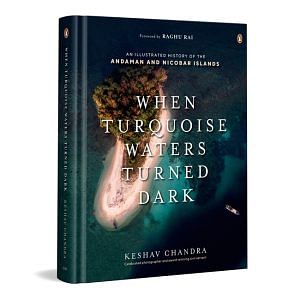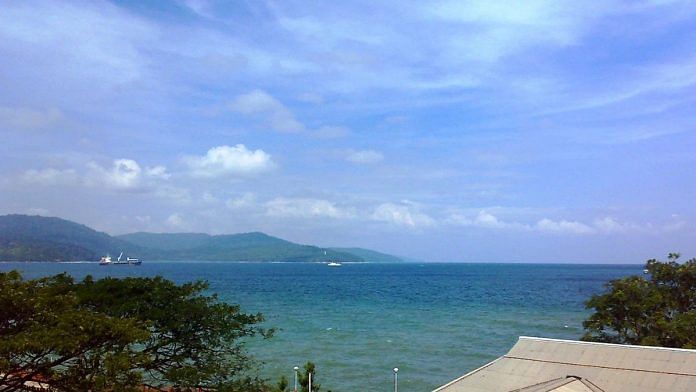Fables about the availability of large quantities of ambergris and quicksilver on the Nicobar Islands in the sixteenth and seventeenth century drew seafarers and merchant voyagers to these islands.
The Italian travellers such as Captain Caesar Fredericke, John Francis Gemelli and Dominic Fernandez, visiting Nicobar during this period had stoked these myths in their accounts. Most merchant vessels veered towards these islands for fresh supplies and engaged with the local population through barter. Sir James Lancaster’s account (1602) of two islands, Pulo Milo and Kondul, is his bartering experience with the local population.
The Nicobarese came into contact with Western missionaries and adventurers long before the British came to the Andamans. In the seventeenth century, Captain William Dampier landed on Nicobar after a mutiny on his ship. He observed that Nicobarese lived an egalitarian life and noted the presence of two Christian missionaries. In 1771, two French Jesuits, Faure and Tailliandiers, stayed at Great Nicobar, Car Nicobar and other islands for over three years without converting a single Nicobarese to Christianity. In 1742, Father Charles de Montalambert spent a year on the islands without any conversion success. After that, four Danish missions came to Nicobar to colonize and convert the local population.
In 1756, the first Danish mission arrived at Great Nicobar, renamed the island Fredricke and set up a commercial centre on the north-east coast. It was later known as Kamorta. Within a year, the entire mission perished due to illness.
Also read: Hitler had chronic flatulence. He took medicine made from faeces of healthy German soldiers
At the Danish king’s request, on behalf of the Danish East India Company, the second mission began after three years. The mission sent five evangelists who got lost in the sea without finding Nicobar, and were finally marooned at Tranquebar. In 1768, the third effort started with the Moravian mission. It had six evangelists, six European soldiers and servants. But they too could not withstand the climate. All supplies for the mission at Nicobar came from Tranquebar, but they always arrived too late. The missionaries and soldiers of the mission fought for their survival without tangible achievements. Eleven missionaries and soldiers died of illness.
Ultimately, the mission fighting for survival in the islands was disbanded in 1787. Later, a Dutch adventurer, William Bolt, settled in Austria, made a plan with the approval of the Austrian queen and financial assistance from a few Antwerp merchants, to launch an expedition to Nicobar. After losing his way between Nicobar and Brazil, he finally landed in Nicobar in April 1778 aboard a ship titled Joseph and Therese. He hoisted the Austrian flag on the island. Within a year, he had to return to negotiate with his financers, for he ran out of money. After his return, he never came back to the islands.
Another Danish mission was launched later but was so ill-planned that they somehow reached Tranquebar. In 1784, they went to Nicobar from Tranquebar. The mission had to retreat in the face of illness and fever. They left a small contingent under one lieutenant, corporal and six privates at Nancowry, which survived until 1807.
Around the same time, the Napoleonic wars started, and the British pushed them out of the islands. But the futility of its occupation became apparent to the British. They handed it back to the Danes in 1814. Several attempts by evangelists to convert the local citizens continued during this period. An Italian Jesuit worked on the islands when the British came in. He left immediately because of a prolonged fever. Danish missionary Dr Rosen stayed on the islands for three years from 1831. Rosen’s collection of Nicobarese words is the surviving work of a missionary on the islands. Two French Jesuits strayed from Malacca in 1836, came to the islands and survived for about a year.
A team of two Jesuits from Siam also faced similar health problems. After several replacements and loss of three lives, they abandoned the islands finally in 1845. Al Moravian missions struggled to survive on the island, let alone carry out their agendas. Their existence only deterred other European powers from entering the islands. The Danish attempted to colonize Nicobar a fourth time in 1845. A Danish corvette, Galatea, was sent to Nicobar with a party to settle and occupy it. At the same time, a Dane called Busch started from Calcutta in L’Espiegle. Busch arrived before and hoisted the Danneborg on Little Nicobar. He invested magisterial powers in two local individuals, gave them ceremonial gowns and instructed them to hoist a flag if they saw an incoming ship. The mission also brought a steamer named Ganges from Calcutta.
They started clearing the jungle with the help of Chinese traders from Penang. The attempt lasted only three years before they abandoned the mission. Fever and illness finally broke their resolve to colonize the islands. In 1848, they closed the mission. The only surviving trace of their colonization attempt is the largest river, still known as the Galatea River. In addition, a river named the Ganges flows through the northern bay. Moreover, Danish words have crept into Nicobarese.
The Moravian mission abandoned a few cattle at Kamorta, which became feral. All the efforts of Moravian missionaries, evangelists and Jesuits hardly impacted the indigenous people’s religious faith. The census of 1901 counted only 136 Christians on the entire island group. It was only due to a local priest that the Nicobarese population converted to Christianity in the twentieth century.
After the repeated attempts of Moravian missions, the only notable attempt to colonize the islands was made by Austrians. The Austrian group was accompanied by Dr Von Hochstetter, who detailed the island’s geological formation and Great Nicobar vegetation. The Austrians named Novara Bay after the vessel that brought them to the island. In 1869, the British finally established their presence in Nicobar. Colonel H. Man set up the Strait Settlement pattern at Chatham and was transferred to Kamorta in 1869. He was sent to curb pirates’ increased activities and thwart other European powers’ ambitions in the area.
 This excerpt from Keshav Chandra’s ‘When the Turquoise Waters Turned Dark’ has been published with permission from Penguin India.
This excerpt from Keshav Chandra’s ‘When the Turquoise Waters Turned Dark’ has been published with permission from Penguin India.






